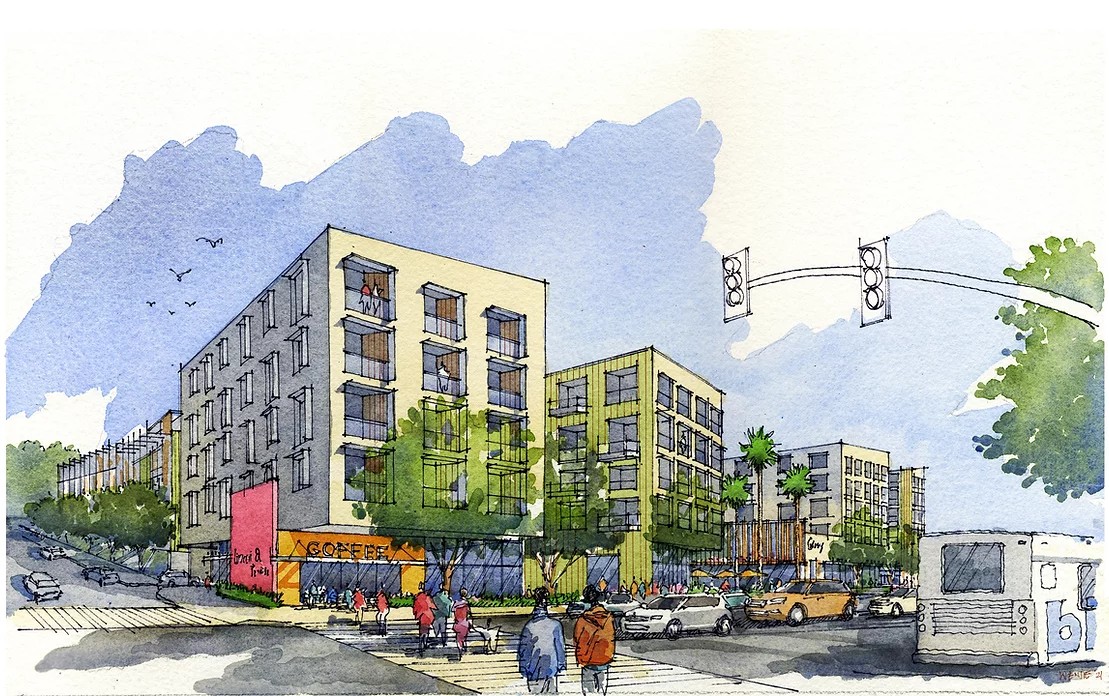
Nine years ago, I wrote a column for SMa.r.t. titled SANTA MONICA: BEACH TOWN OR ‘DINGBAT’ CITY? (https://smdp.com/2015/05/09/santa-monica-beach-town-dingbat-city/)
Here is the first paragraph from that column.
“In the late 1950s, ’60s, and into the ’70s, there was an architect in Los Angeles that picked up the sobriquet of ‘Crammin’ Jack. This architect seemingly could cram one unit more than anyone else into any apartment project he was asked to maximize. And he designed a lot of them, two stories, open parking under the second floor, often open to the street. Sometimes, some stone or brick element would be stuck on the stucco facade, or maybe a big starburst or palm tree and emblazoned with a name like “Riviera” or ‘The Palms’ to create a hoped for illusion of the Southern California dream. Small units, with one or two bedrooms, one bath, small kitchen open to the living room, and often not more than four to eight units per building.
These apartments came to be known years later, as they began to deteriorate, as “dingbats.” The column goes on to describe that while the architect was perhaps successfully serving his client by ‘cramming in that one more unit, thereby being more profitable for the developer, the real cost was a diminishing quality of life for both the occupants and the surrounding neighborhood environment. The column then went on to say, “But if the design criteria are expanded even a little, to include such desirable elements as light and air, scale and proportion, sustainability and energy efficiency, privacy, and sound separation, then maybe the “dingbats” were not such good designs. In fact, pretty poor on the scale of most people’s sensibilities.” and “Don’t most people want and need to live in a healthy environment that includes the elements missing from the “dingbats?” Shouldn’t light, openness, blue sky, scale and proportion, privacy, sustainability, and amenities such as courtyards, with trees and landscaping that enhance one’s quality of life, be included in any client’s project?”
Apparently, neither the state nor past city councils and planning commissions have thought so, considering the devolution of those quality of life issues that have become less and less required in any residential development currently being proposed and built. We even have an ARB (Architectural Review Board) that is charged with seeing that such basic qualities are an integral part of any design submission, multi-residential or commercial, but they, too, have been eviscerated and seem fearful to speak truth to power. First by previous ideologically driven city councils, planning staff, and planning commissions that never seemed to hear residents concerns about over development and loss of quality of life, and then their reluctance to push back against creeping state housing density regulations promulgated, one suspects, by developer interests and their profitability. It certainly could not be motivated by a desire to increase the occupants quality of life, given the recent housing projects submitted.
That column was an attempt to point out what seemed to be an obvious concern about the direction our beachfront town was heading in hopes that those driving the critical planning decisions would actually realize they were pushing closer to a precipice. Unfortunately, to little avail, and obvious deaf ears, as the planning decision makers continued to careen seemingly out of control toward that cliff. There were already signs, several years ago, of the state stepping up their housing bills, always using words like ‘critical housing crisis,’ but basically pandering to market rate building and profitability rather than to the factual need for only low/moderate income housing affordability. And no push back from our city when it may have done some good in helping to curtail the predictable state onslaught.
Almost four years ago, the city was required to prepare and submit to the State HCD (Housing and Community Development) a new General Plan Housing Element (HE). Committees were formed of community members under the control of the city planning staff, and workshops were conducted to discuss and ‘suggest’ zoning changes to accommodate new state mandated housing numbers known as RHNA (Regional Housing Needs Assessment) that had been foisted upon our town. Again, with little to no push back about requiring us to provide for about 9000 new units by 2028. That was one opportunity for the city to push back, and the HE, while more limited, was another and another failure. There were vested interests involved in the proposed changes that may have influenced, in some cases, specific projects they were apparently engaged in, that provided those projects additional benefits if adopted in the code. While there may be nothing illegal about that sort of conflict of interest, it is against the AIA Code of Ethics & Professional Conduct if such an action was taken by an architect member of the AIA.
So, with little to no pushback and projects now submitted that make Crammin’ Jack look like a piker two years ago, I followed up with another column about crammin’. In this case, more than just one more unit, and titled “CRAMMIN’ JACK IS BACK! ‘DINGBAT’ CITY IS HERE!” (https://smmirror.com/2022/02/crammin-jack-is-back-dingbat-city-is-here/).
Part of that column states, “Well, it appears that massive negative development has arrived, in vivid form, reflecting the community risks that arise from development that seemingly unrestrained profit driven densification produces. Just imagine how excited Crammin’ Jack’s clients would have been had their projects not been limited to two stories but instead have been allowed six or more. Like many of the new projects seen throughout downtown Santa Monica and other current ‘in the works’ projects, such as at Ocean Park and Lincoln Blvd. and other locations throughout what used to be our low-rise beach town, with heights in the 65 to 80 ft range. And why worry about designs that would be family-friendly, just unleash designs predicated on housing only one or two occupants, thereby crammin’ mostly single- and one bedroom units into the developments. More ROI per sq. ft. of building.” (Return On Investment)
Crammin’ Jack’s projects pale in comparison to the current rash of projects such as the Gelson’s at Ocean Park Bl and Lincoln Bl, where twelve structures up to almost 80ft tall are squeezed together with balconies about 13-14ft apart, and with minimal open space it will be lucky if sunlight ever hits the lower levels and ground. Reminiscent of the old New York tenement buildings that were known as “dumbbell” apartments due to their configuration and minimum light and natural ventilation, they were ultimately outlawed and demolished. Not expecting that to happen here, but in the case of the Gelson’s project, the ARB didn’t have the courage to speak truth to power, telling it like it is, how unlivable that project will be. Even knowing their hands may have been tied, why could they not have put staff and the city on notice that they know bad when they see it. Some may remember the POW in Vietnam, forced on TV to say they were treated well, had the courage to blink his eyes in Morse code stating “torture.” Won’t someone in this city blink a message to the ‘powers that be’ to just stop.
Bob Taylor, AIA
for SMa.r.t.
Send comments to santamonicasmart@gmail.com
Santa Monica Architects for a Responsible Tomorrow
Robert H. Taylor AIA, Architect; Dan Jansenson, Architect & Building and Fire-Life Safety Commission; Thane Roberts, Architect; Mario Fonda-Bonardi AIA, Architect; Samuel Tolkin Architect & Planning Commissioner; Michael Jolly, AIR-CRE; Marie Standing, Resident; Jack Hillbrand AIA, Architect
For previous articles, see www.santamonicaarch.wordpress.com/writing













